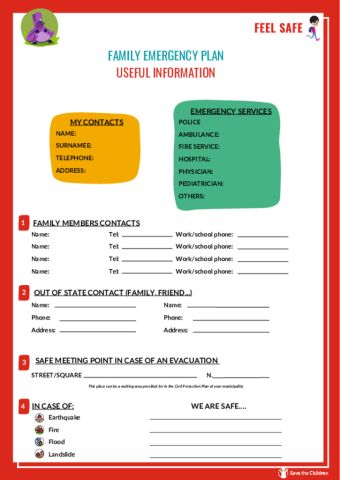Family Emergency Plan
Objectives:
- Enhance individual awareness and preparedness for emergencies.
- Increase awareness and preparedness among others in case of an emergency.
STEP BY STEP
Before starting
The teacher writes the word "preparedness" on the blackboard and explains its importance in dealing with emergencies. The teacher poses the following questions to the class:
- When do we prepare?
- Why is preparation important?
The teacher emphasizes that we should prepare before an emergency occurs, when we can think clearly and calmly—something that’s often difficult during a crisis. For instance, when an earthquake strikes, it’s unrealistic to search for necessary items at home. However, if these items are already organized in a backpack, we can access them immediately. Preparation helps minimize the impact of disasters. While we cannot predict the intensity or occurrence of a disaster, knowing what to do can significantly improve our safety.
THE FOUR C-Ws OF THE FAMILY EMERGENCY PLAN
The teacher introduces the concept of a family emergency plan by asking the class several stimulating questions:
- What is it?
- Who should compile it?
- Who should know it?
- What should it contain?
Guiding Answers:
- What it is: A family emergency plan is a document that lists important information and steps to take during an emergency.
- Who should fill it out: All family members should participate in creating the plan.
- Who needs to know it: Every family member should be aware of the plan and have a copy.
- What must the plan contain: The plan should include crucial information that family members and outside responders may need. Being prepared is vital for effectively managing emergencies.
Before distributing the emergency plan template (see attached "Family Emergency Plan - Template" below), the teacher asks the class:
- What information do you think should be included in a family emergency plan?
- What items would you pack in your emergency backpack Collection of basic necessities (e.g., food and water) and basic equipment (e.g., torch and batteries) inside a backpack that can be easily reached and carried in an emergency and allows survival for at least 48h/72h ?
LET'S PREPARE THE PLAN AT HOME
The teacher hands out copies of the "Family Emergency Plan" template to each student. The class reads through the document together, discussing its contents.
Students are instructed to complete the emergency plan with their families and store it in their emergency backpacks at home.
Class Sharing: When the class reconvenes, the teacher facilitates a discussion using the following guiding questions:
- Did your family know about the emergency plan?
- How many of you completed it?
- Did you review the completed plan together and make copies for each family member?
- Did you encounter any difficulties in completing the plan?
CONCLUDING THOUGHTS
To encourage students to think about ways to promote safety A condition that makes one feel that one is not in danger or that a risk can be prevented or reduced within their families, the teacher asks the class the following questions:
- Do you think your family understood the importance of this activity?
- If not, how can we continue discussing safety and improve our preparedness?

Add new comment